Organisational Analysis: A Case Study of All Seasons Knitwear
VerifiedAdded on 2022/11/14
|9
|1995
|446
Case Study
AI Summary
This case study undertakes a critical analysis of "All Seasons," a fine woollen knitwear manufacturer, examining its business model, organizational structure, resources, and processes. Established in 1962, the company designs, manufactures, and retails its products, focusing on quality and sustainability. The analysis explores the organizational resources needed, such as the effective use of wool through recycling, and the importance of business processes like quality control. It further discusses the placement of resources and processes within the operations, the regulatory measures for control, and the overall organizational structure, highlighting how these elements contribute to the company's success. The study emphasizes the significance of organizational structure, business processes, and control measures in effectively utilizing resources and ensuring product quality.
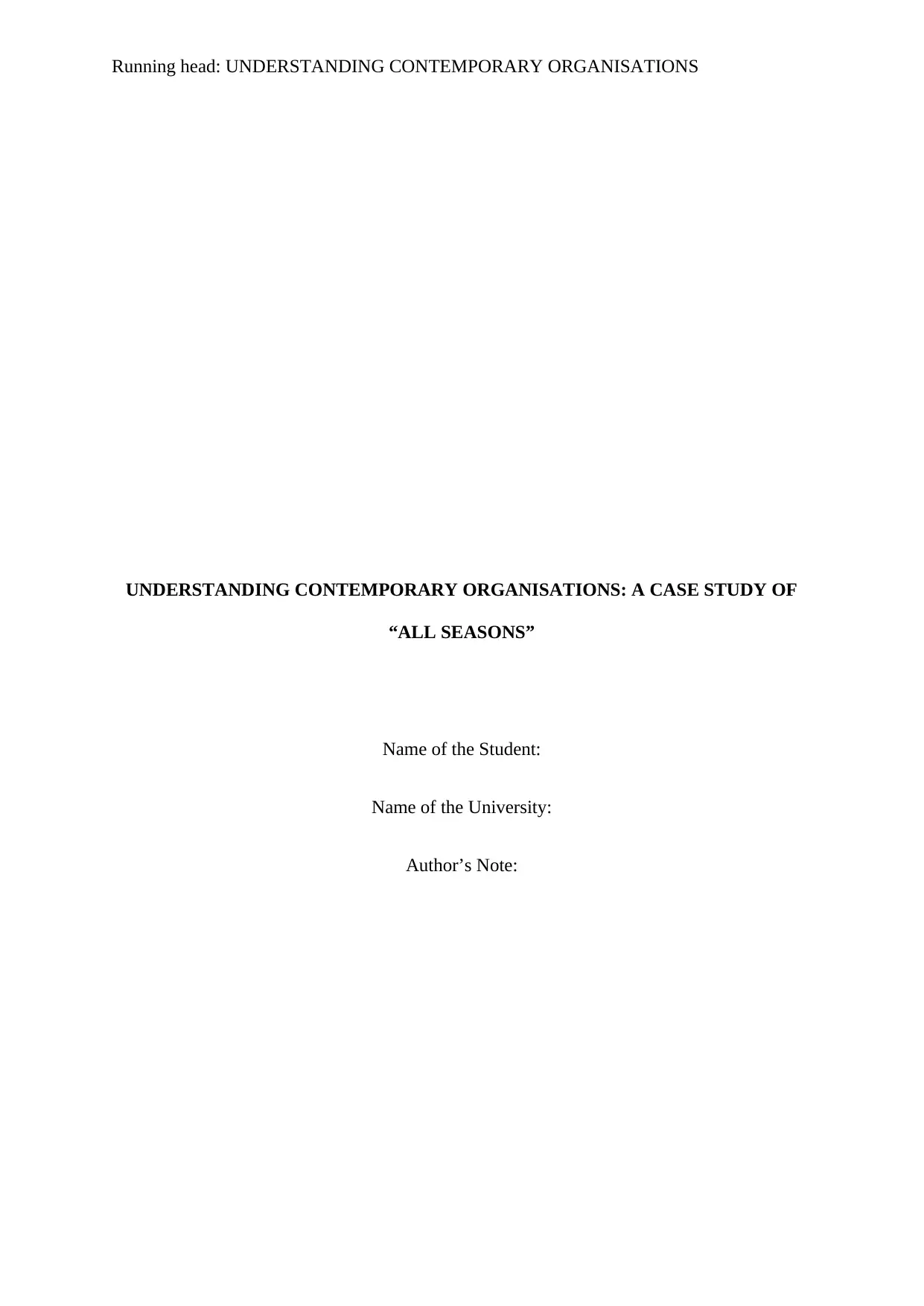
Running head: UNDERSTANDING CONTEMPORARY ORGANISATIONS
UNDERSTANDING CONTEMPORARY ORGANISATIONS: A CASE STUDY OF
“ALL SEASONS”
Name of the Student:
Name of the University:
Author’s Note:
UNDERSTANDING CONTEMPORARY ORGANISATIONS: A CASE STUDY OF
“ALL SEASONS”
Name of the Student:
Name of the University:
Author’s Note:
Paraphrase This Document
Need a fresh take? Get an instant paraphrase of this document with our AI Paraphraser
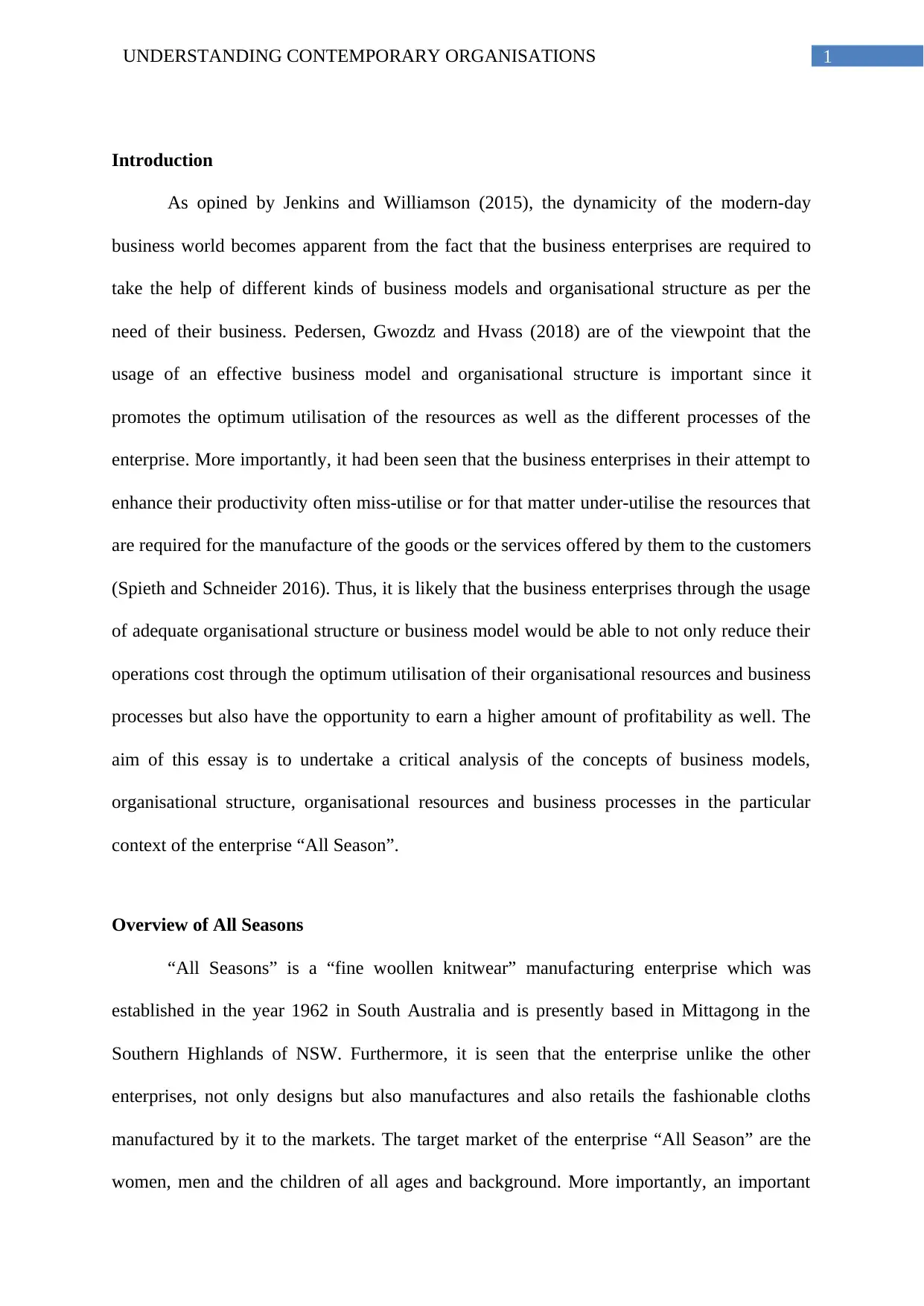
1UNDERSTANDING CONTEMPORARY ORGANISATIONS
Introduction
As opined by Jenkins and Williamson (2015), the dynamicity of the modern-day
business world becomes apparent from the fact that the business enterprises are required to
take the help of different kinds of business models and organisational structure as per the
need of their business. Pedersen, Gwozdz and Hvass (2018) are of the viewpoint that the
usage of an effective business model and organisational structure is important since it
promotes the optimum utilisation of the resources as well as the different processes of the
enterprise. More importantly, it had been seen that the business enterprises in their attempt to
enhance their productivity often miss-utilise or for that matter under-utilise the resources that
are required for the manufacture of the goods or the services offered by them to the customers
(Spieth and Schneider 2016). Thus, it is likely that the business enterprises through the usage
of adequate organisational structure or business model would be able to not only reduce their
operations cost through the optimum utilisation of their organisational resources and business
processes but also have the opportunity to earn a higher amount of profitability as well. The
aim of this essay is to undertake a critical analysis of the concepts of business models,
organisational structure, organisational resources and business processes in the particular
context of the enterprise “All Season”.
Overview of All Seasons
“All Seasons” is a “fine woollen knitwear” manufacturing enterprise which was
established in the year 1962 in South Australia and is presently based in Mittagong in the
Southern Highlands of NSW. Furthermore, it is seen that the enterprise unlike the other
enterprises, not only designs but also manufactures and also retails the fashionable cloths
manufactured by it to the markets. The target market of the enterprise “All Season” are the
women, men and the children of all ages and background. More importantly, an important
Introduction
As opined by Jenkins and Williamson (2015), the dynamicity of the modern-day
business world becomes apparent from the fact that the business enterprises are required to
take the help of different kinds of business models and organisational structure as per the
need of their business. Pedersen, Gwozdz and Hvass (2018) are of the viewpoint that the
usage of an effective business model and organisational structure is important since it
promotes the optimum utilisation of the resources as well as the different processes of the
enterprise. More importantly, it had been seen that the business enterprises in their attempt to
enhance their productivity often miss-utilise or for that matter under-utilise the resources that
are required for the manufacture of the goods or the services offered by them to the customers
(Spieth and Schneider 2016). Thus, it is likely that the business enterprises through the usage
of adequate organisational structure or business model would be able to not only reduce their
operations cost through the optimum utilisation of their organisational resources and business
processes but also have the opportunity to earn a higher amount of profitability as well. The
aim of this essay is to undertake a critical analysis of the concepts of business models,
organisational structure, organisational resources and business processes in the particular
context of the enterprise “All Season”.
Overview of All Seasons
“All Seasons” is a “fine woollen knitwear” manufacturing enterprise which was
established in the year 1962 in South Australia and is presently based in Mittagong in the
Southern Highlands of NSW. Furthermore, it is seen that the enterprise unlike the other
enterprises, not only designs but also manufactures and also retails the fashionable cloths
manufactured by it to the markets. The target market of the enterprise “All Season” are the
women, men and the children of all ages and background. More importantly, an important
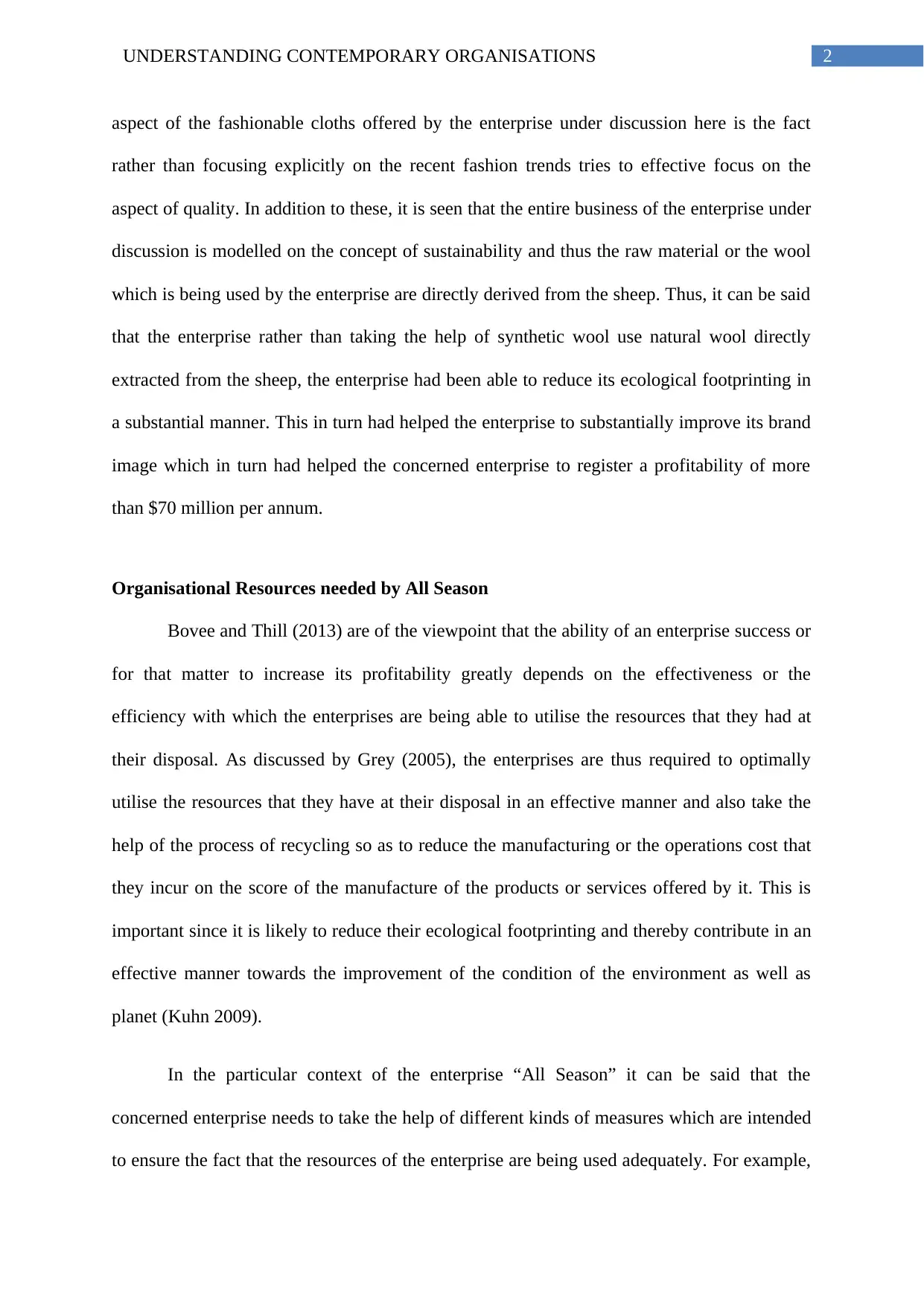
2UNDERSTANDING CONTEMPORARY ORGANISATIONS
aspect of the fashionable cloths offered by the enterprise under discussion here is the fact
rather than focusing explicitly on the recent fashion trends tries to effective focus on the
aspect of quality. In addition to these, it is seen that the entire business of the enterprise under
discussion is modelled on the concept of sustainability and thus the raw material or the wool
which is being used by the enterprise are directly derived from the sheep. Thus, it can be said
that the enterprise rather than taking the help of synthetic wool use natural wool directly
extracted from the sheep, the enterprise had been able to reduce its ecological footprinting in
a substantial manner. This in turn had helped the enterprise to substantially improve its brand
image which in turn had helped the concerned enterprise to register a profitability of more
than $70 million per annum.
Organisational Resources needed by All Season
Bovee and Thill (2013) are of the viewpoint that the ability of an enterprise success or
for that matter to increase its profitability greatly depends on the effectiveness or the
efficiency with which the enterprises are being able to utilise the resources that they had at
their disposal. As discussed by Grey (2005), the enterprises are thus required to optimally
utilise the resources that they have at their disposal in an effective manner and also take the
help of the process of recycling so as to reduce the manufacturing or the operations cost that
they incur on the score of the manufacture of the products or services offered by it. This is
important since it is likely to reduce their ecological footprinting and thereby contribute in an
effective manner towards the improvement of the condition of the environment as well as
planet (Kuhn 2009).
In the particular context of the enterprise “All Season” it can be said that the
concerned enterprise needs to take the help of different kinds of measures which are intended
to ensure the fact that the resources of the enterprise are being used adequately. For example,
aspect of the fashionable cloths offered by the enterprise under discussion here is the fact
rather than focusing explicitly on the recent fashion trends tries to effective focus on the
aspect of quality. In addition to these, it is seen that the entire business of the enterprise under
discussion is modelled on the concept of sustainability and thus the raw material or the wool
which is being used by the enterprise are directly derived from the sheep. Thus, it can be said
that the enterprise rather than taking the help of synthetic wool use natural wool directly
extracted from the sheep, the enterprise had been able to reduce its ecological footprinting in
a substantial manner. This in turn had helped the enterprise to substantially improve its brand
image which in turn had helped the concerned enterprise to register a profitability of more
than $70 million per annum.
Organisational Resources needed by All Season
Bovee and Thill (2013) are of the viewpoint that the ability of an enterprise success or
for that matter to increase its profitability greatly depends on the effectiveness or the
efficiency with which the enterprises are being able to utilise the resources that they had at
their disposal. As discussed by Grey (2005), the enterprises are thus required to optimally
utilise the resources that they have at their disposal in an effective manner and also take the
help of the process of recycling so as to reduce the manufacturing or the operations cost that
they incur on the score of the manufacture of the products or services offered by it. This is
important since it is likely to reduce their ecological footprinting and thereby contribute in an
effective manner towards the improvement of the condition of the environment as well as
planet (Kuhn 2009).
In the particular context of the enterprise “All Season” it can be said that the
concerned enterprise needs to take the help of different kinds of measures which are intended
to ensure the fact that the resources of the enterprise are being used adequately. For example,
⊘ This is a preview!⊘
Do you want full access?
Subscribe today to unlock all pages.

Trusted by 1+ million students worldwide
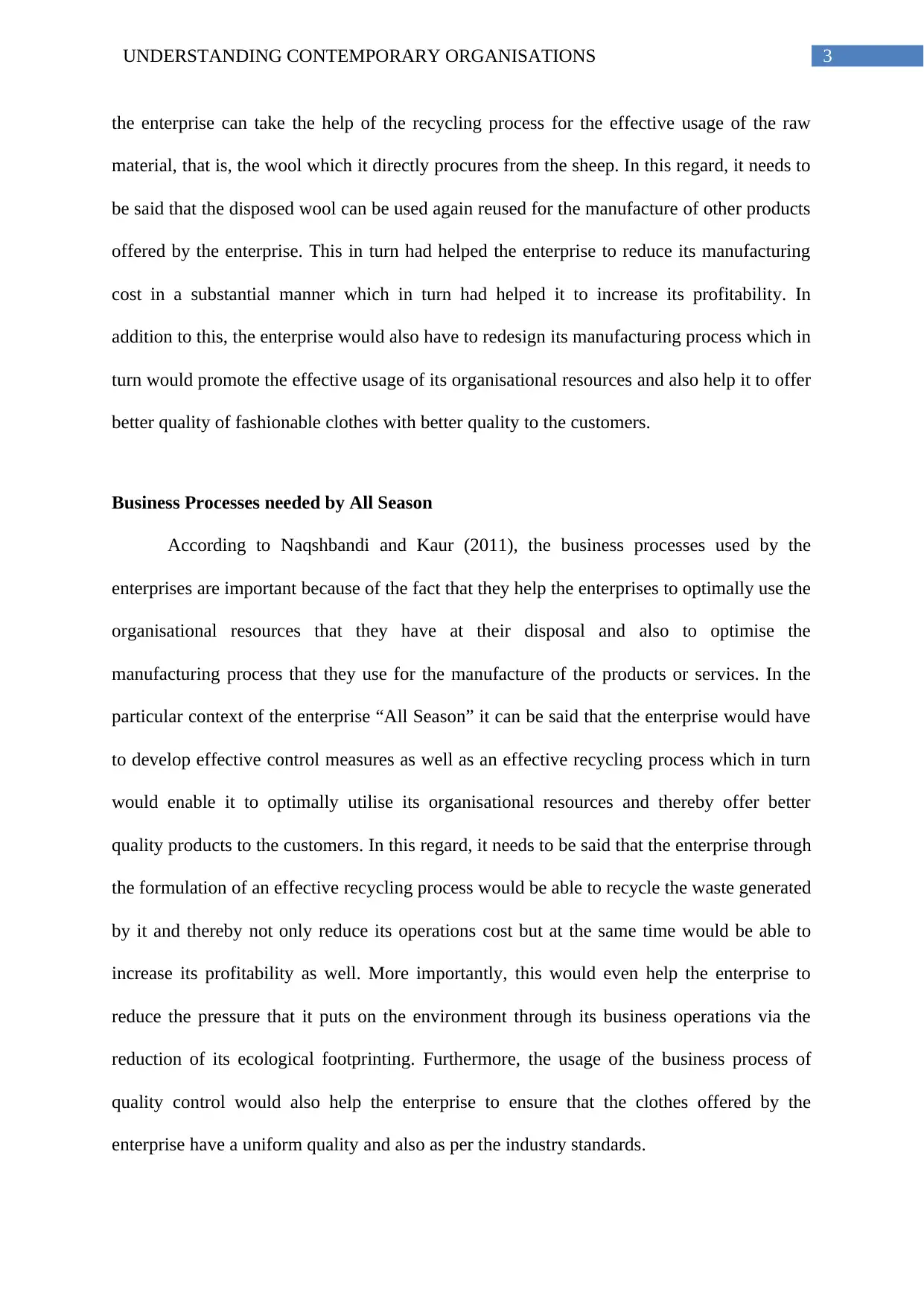
3UNDERSTANDING CONTEMPORARY ORGANISATIONS
the enterprise can take the help of the recycling process for the effective usage of the raw
material, that is, the wool which it directly procures from the sheep. In this regard, it needs to
be said that the disposed wool can be used again reused for the manufacture of other products
offered by the enterprise. This in turn had helped the enterprise to reduce its manufacturing
cost in a substantial manner which in turn had helped it to increase its profitability. In
addition to this, the enterprise would also have to redesign its manufacturing process which in
turn would promote the effective usage of its organisational resources and also help it to offer
better quality of fashionable clothes with better quality to the customers.
Business Processes needed by All Season
According to Naqshbandi and Kaur (2011), the business processes used by the
enterprises are important because of the fact that they help the enterprises to optimally use the
organisational resources that they have at their disposal and also to optimise the
manufacturing process that they use for the manufacture of the products or services. In the
particular context of the enterprise “All Season” it can be said that the enterprise would have
to develop effective control measures as well as an effective recycling process which in turn
would enable it to optimally utilise its organisational resources and thereby offer better
quality products to the customers. In this regard, it needs to be said that the enterprise through
the formulation of an effective recycling process would be able to recycle the waste generated
by it and thereby not only reduce its operations cost but at the same time would be able to
increase its profitability as well. More importantly, this would even help the enterprise to
reduce the pressure that it puts on the environment through its business operations via the
reduction of its ecological footprinting. Furthermore, the usage of the business process of
quality control would also help the enterprise to ensure that the clothes offered by the
enterprise have a uniform quality and also as per the industry standards.
the enterprise can take the help of the recycling process for the effective usage of the raw
material, that is, the wool which it directly procures from the sheep. In this regard, it needs to
be said that the disposed wool can be used again reused for the manufacture of other products
offered by the enterprise. This in turn had helped the enterprise to reduce its manufacturing
cost in a substantial manner which in turn had helped it to increase its profitability. In
addition to this, the enterprise would also have to redesign its manufacturing process which in
turn would promote the effective usage of its organisational resources and also help it to offer
better quality of fashionable clothes with better quality to the customers.
Business Processes needed by All Season
According to Naqshbandi and Kaur (2011), the business processes used by the
enterprises are important because of the fact that they help the enterprises to optimally use the
organisational resources that they have at their disposal and also to optimise the
manufacturing process that they use for the manufacture of the products or services. In the
particular context of the enterprise “All Season” it can be said that the enterprise would have
to develop effective control measures as well as an effective recycling process which in turn
would enable it to optimally utilise its organisational resources and thereby offer better
quality products to the customers. In this regard, it needs to be said that the enterprise through
the formulation of an effective recycling process would be able to recycle the waste generated
by it and thereby not only reduce its operations cost but at the same time would be able to
increase its profitability as well. More importantly, this would even help the enterprise to
reduce the pressure that it puts on the environment through its business operations via the
reduction of its ecological footprinting. Furthermore, the usage of the business process of
quality control would also help the enterprise to ensure that the clothes offered by the
enterprise have a uniform quality and also as per the industry standards.
Paraphrase This Document
Need a fresh take? Get an instant paraphrase of this document with our AI Paraphraser
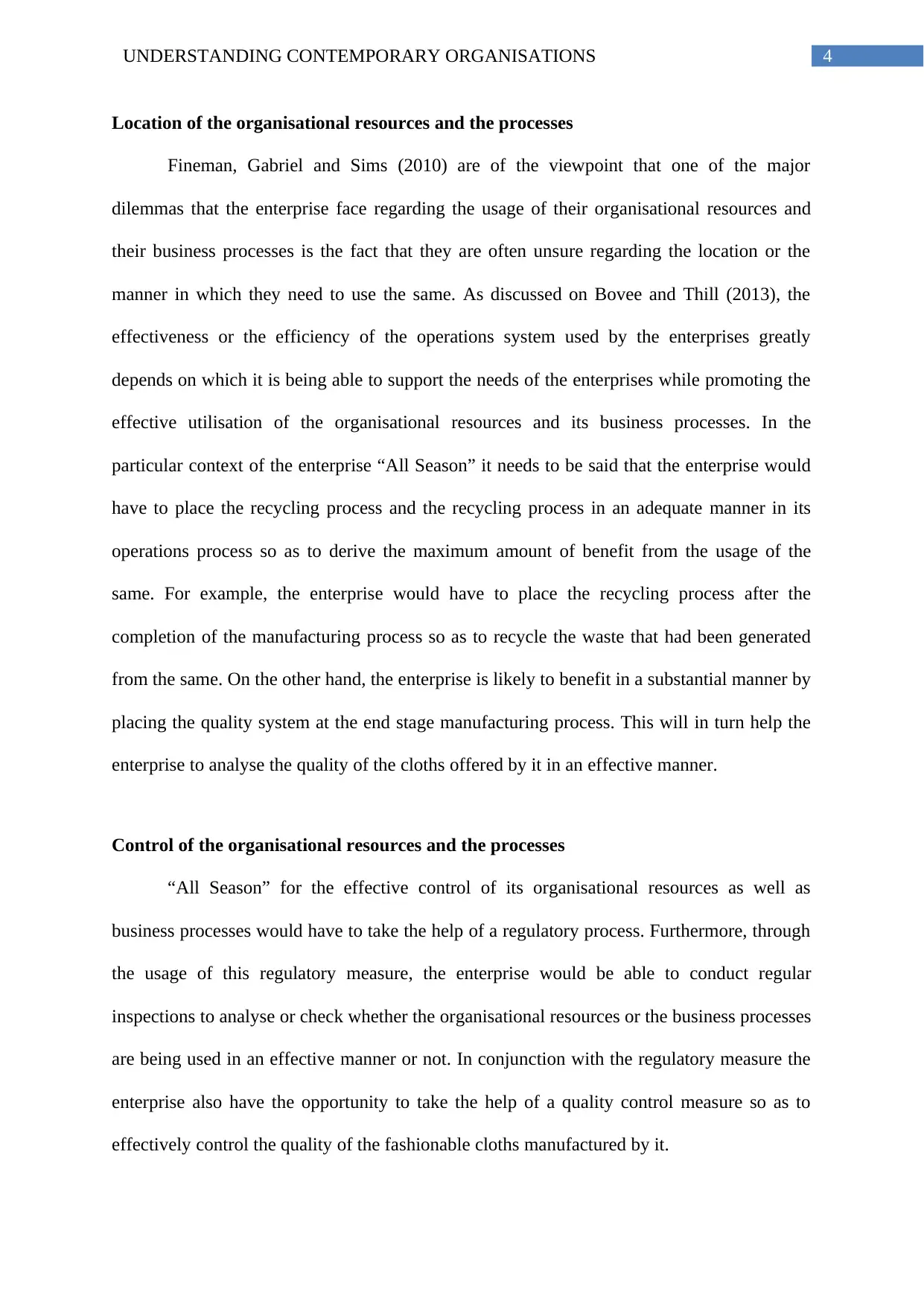
4UNDERSTANDING CONTEMPORARY ORGANISATIONS
Location of the organisational resources and the processes
Fineman, Gabriel and Sims (2010) are of the viewpoint that one of the major
dilemmas that the enterprise face regarding the usage of their organisational resources and
their business processes is the fact that they are often unsure regarding the location or the
manner in which they need to use the same. As discussed on Bovee and Thill (2013), the
effectiveness or the efficiency of the operations system used by the enterprises greatly
depends on which it is being able to support the needs of the enterprises while promoting the
effective utilisation of the organisational resources and its business processes. In the
particular context of the enterprise “All Season” it needs to be said that the enterprise would
have to place the recycling process and the recycling process in an adequate manner in its
operations process so as to derive the maximum amount of benefit from the usage of the
same. For example, the enterprise would have to place the recycling process after the
completion of the manufacturing process so as to recycle the waste that had been generated
from the same. On the other hand, the enterprise is likely to benefit in a substantial manner by
placing the quality system at the end stage manufacturing process. This will in turn help the
enterprise to analyse the quality of the cloths offered by it in an effective manner.
Control of the organisational resources and the processes
“All Season” for the effective control of its organisational resources as well as
business processes would have to take the help of a regulatory process. Furthermore, through
the usage of this regulatory measure, the enterprise would be able to conduct regular
inspections to analyse or check whether the organisational resources or the business processes
are being used in an effective manner or not. In conjunction with the regulatory measure the
enterprise also have the opportunity to take the help of a quality control measure so as to
effectively control the quality of the fashionable cloths manufactured by it.
Location of the organisational resources and the processes
Fineman, Gabriel and Sims (2010) are of the viewpoint that one of the major
dilemmas that the enterprise face regarding the usage of their organisational resources and
their business processes is the fact that they are often unsure regarding the location or the
manner in which they need to use the same. As discussed on Bovee and Thill (2013), the
effectiveness or the efficiency of the operations system used by the enterprises greatly
depends on which it is being able to support the needs of the enterprises while promoting the
effective utilisation of the organisational resources and its business processes. In the
particular context of the enterprise “All Season” it needs to be said that the enterprise would
have to place the recycling process and the recycling process in an adequate manner in its
operations process so as to derive the maximum amount of benefit from the usage of the
same. For example, the enterprise would have to place the recycling process after the
completion of the manufacturing process so as to recycle the waste that had been generated
from the same. On the other hand, the enterprise is likely to benefit in a substantial manner by
placing the quality system at the end stage manufacturing process. This will in turn help the
enterprise to analyse the quality of the cloths offered by it in an effective manner.
Control of the organisational resources and the processes
“All Season” for the effective control of its organisational resources as well as
business processes would have to take the help of a regulatory process. Furthermore, through
the usage of this regulatory measure, the enterprise would be able to conduct regular
inspections to analyse or check whether the organisational resources or the business processes
are being used in an effective manner or not. In conjunction with the regulatory measure the
enterprise also have the opportunity to take the help of a quality control measure so as to
effectively control the quality of the fashionable cloths manufactured by it.
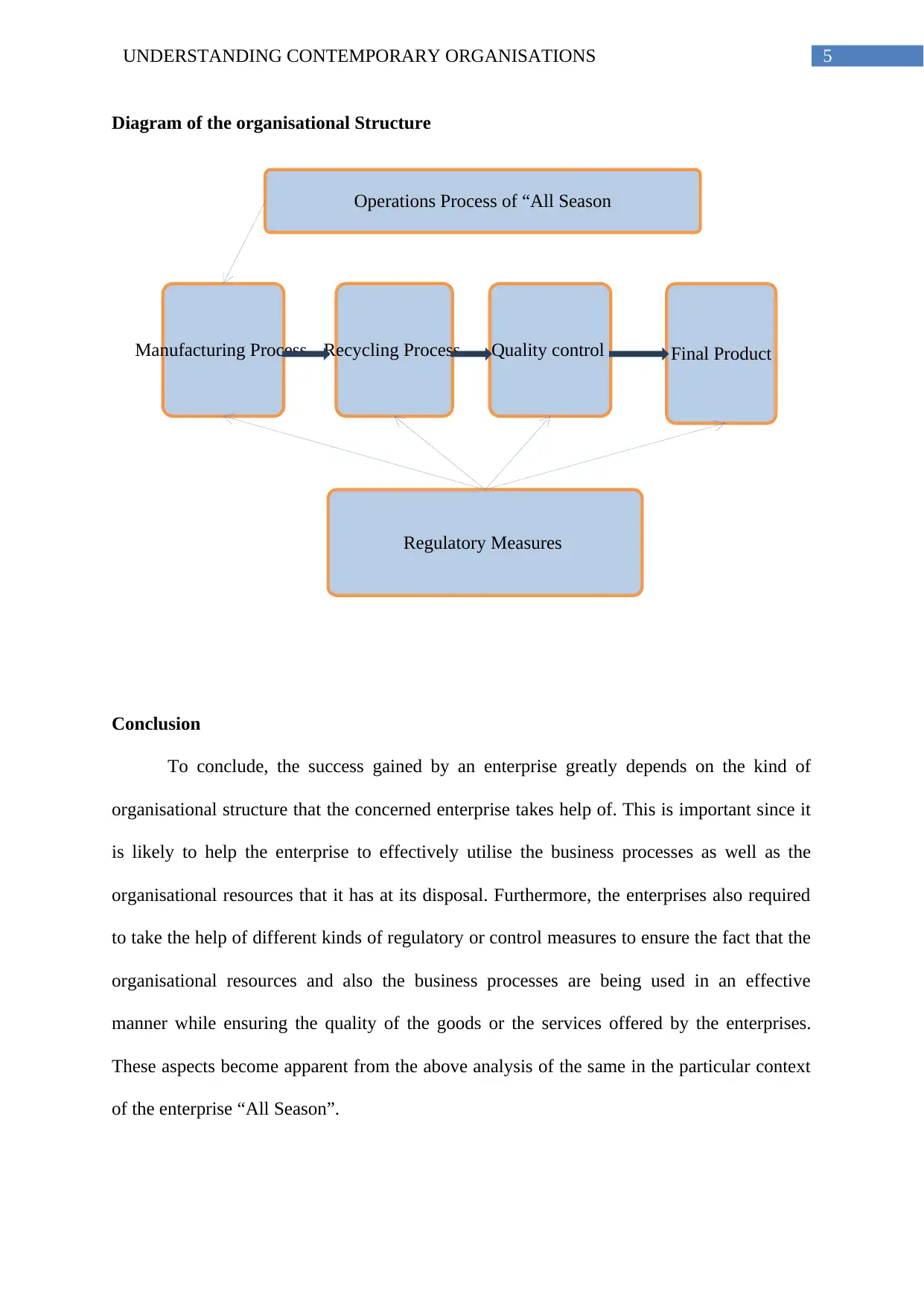
5UNDERSTANDING CONTEMPORARY ORGANISATIONS
Operations Process of “All Season
Manufacturing Process Recycling Process Quality control Final Product
Regulatory Measures
Diagram of the organisational Structure
Conclusion
To conclude, the success gained by an enterprise greatly depends on the kind of
organisational structure that the concerned enterprise takes help of. This is important since it
is likely to help the enterprise to effectively utilise the business processes as well as the
organisational resources that it has at its disposal. Furthermore, the enterprises also required
to take the help of different kinds of regulatory or control measures to ensure the fact that the
organisational resources and also the business processes are being used in an effective
manner while ensuring the quality of the goods or the services offered by the enterprises.
These aspects become apparent from the above analysis of the same in the particular context
of the enterprise “All Season”.
Operations Process of “All Season
Manufacturing Process Recycling Process Quality control Final Product
Regulatory Measures
Diagram of the organisational Structure
Conclusion
To conclude, the success gained by an enterprise greatly depends on the kind of
organisational structure that the concerned enterprise takes help of. This is important since it
is likely to help the enterprise to effectively utilise the business processes as well as the
organisational resources that it has at its disposal. Furthermore, the enterprises also required
to take the help of different kinds of regulatory or control measures to ensure the fact that the
organisational resources and also the business processes are being used in an effective
manner while ensuring the quality of the goods or the services offered by the enterprises.
These aspects become apparent from the above analysis of the same in the particular context
of the enterprise “All Season”.
⊘ This is a preview!⊘
Do you want full access?
Subscribe today to unlock all pages.

Trusted by 1+ million students worldwide

6UNDERSTANDING CONTEMPORARY ORGANISATIONS
Paraphrase This Document
Need a fresh take? Get an instant paraphrase of this document with our AI Paraphraser
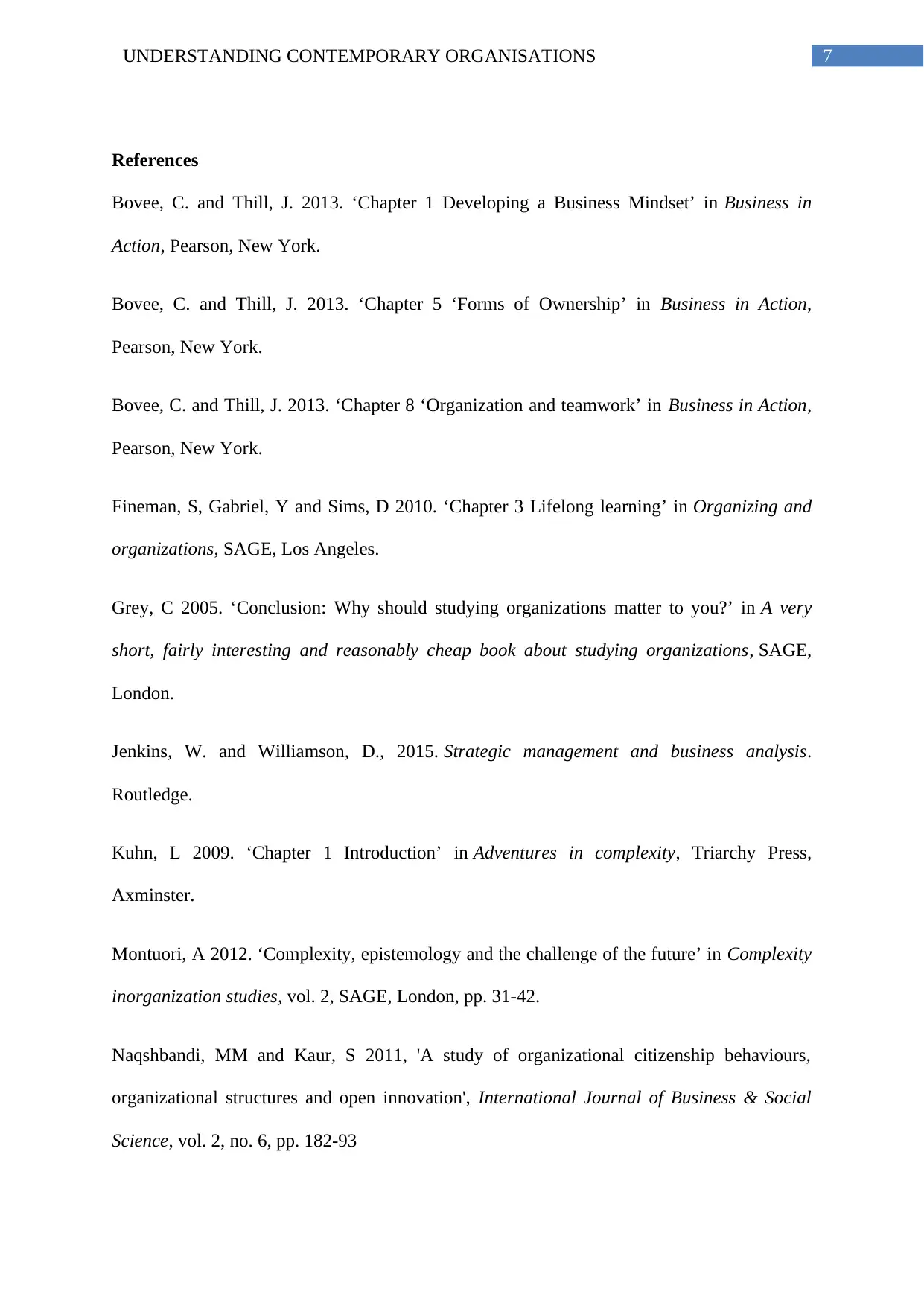
7UNDERSTANDING CONTEMPORARY ORGANISATIONS
References
Bovee, C. and Thill, J. 2013. ‘Chapter 1 Developing a Business Mindset’ in Business in
Action, Pearson, New York.
Bovee, C. and Thill, J. 2013. ‘Chapter 5 ‘Forms of Ownership’ in Business in Action,
Pearson, New York.
Bovee, C. and Thill, J. 2013. ‘Chapter 8 ‘Organization and teamwork’ in Business in Action,
Pearson, New York.
Fineman, S, Gabriel, Y and Sims, D 2010. ‘Chapter 3 Lifelong learning’ in Organizing and
organizations, SAGE, Los Angeles.
Grey, C 2005. ‘Conclusion: Why should studying organizations matter to you?’ in A very
short, fairly interesting and reasonably cheap book about studying organizations, SAGE,
London.
Jenkins, W. and Williamson, D., 2015. Strategic management and business analysis.
Routledge.
Kuhn, L 2009. ‘Chapter 1 Introduction’ in Adventures in complexity, Triarchy Press,
Axminster.
Montuori, A 2012. ‘Complexity, epistemology and the challenge of the future’ in Complexity
inorganization studies, vol. 2, SAGE, London, pp. 31-42.
Naqshbandi, MM and Kaur, S 2011, 'A study of organizational citizenship behaviours,
organizational structures and open innovation', International Journal of Business & Social
Science, vol. 2, no. 6, pp. 182-93
References
Bovee, C. and Thill, J. 2013. ‘Chapter 1 Developing a Business Mindset’ in Business in
Action, Pearson, New York.
Bovee, C. and Thill, J. 2013. ‘Chapter 5 ‘Forms of Ownership’ in Business in Action,
Pearson, New York.
Bovee, C. and Thill, J. 2013. ‘Chapter 8 ‘Organization and teamwork’ in Business in Action,
Pearson, New York.
Fineman, S, Gabriel, Y and Sims, D 2010. ‘Chapter 3 Lifelong learning’ in Organizing and
organizations, SAGE, Los Angeles.
Grey, C 2005. ‘Conclusion: Why should studying organizations matter to you?’ in A very
short, fairly interesting and reasonably cheap book about studying organizations, SAGE,
London.
Jenkins, W. and Williamson, D., 2015. Strategic management and business analysis.
Routledge.
Kuhn, L 2009. ‘Chapter 1 Introduction’ in Adventures in complexity, Triarchy Press,
Axminster.
Montuori, A 2012. ‘Complexity, epistemology and the challenge of the future’ in Complexity
inorganization studies, vol. 2, SAGE, London, pp. 31-42.
Naqshbandi, MM and Kaur, S 2011, 'A study of organizational citizenship behaviours,
organizational structures and open innovation', International Journal of Business & Social
Science, vol. 2, no. 6, pp. 182-93
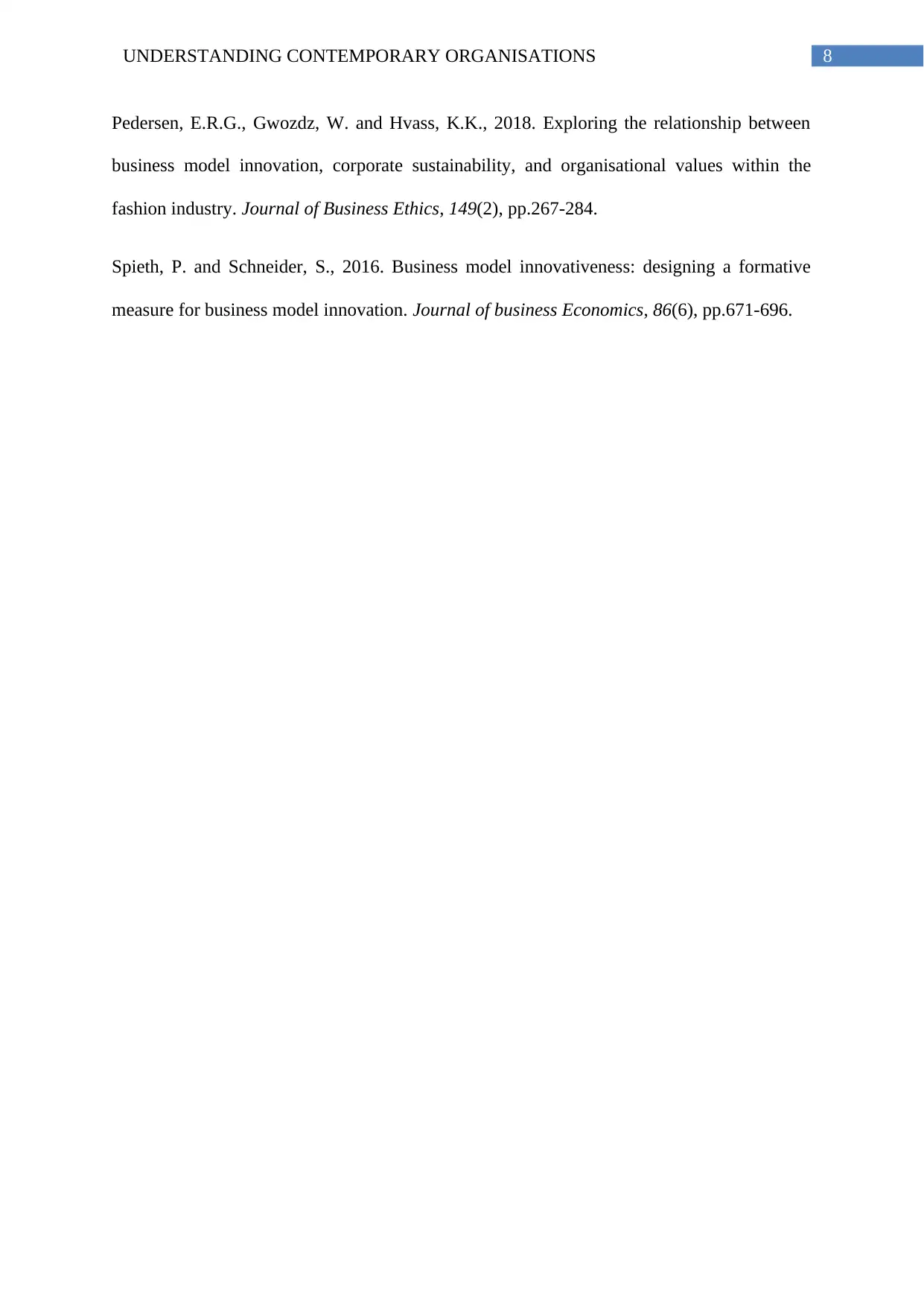
8UNDERSTANDING CONTEMPORARY ORGANISATIONS
Pedersen, E.R.G., Gwozdz, W. and Hvass, K.K., 2018. Exploring the relationship between
business model innovation, corporate sustainability, and organisational values within the
fashion industry. Journal of Business Ethics, 149(2), pp.267-284.
Spieth, P. and Schneider, S., 2016. Business model innovativeness: designing a formative
measure for business model innovation. Journal of business Economics, 86(6), pp.671-696.
Pedersen, E.R.G., Gwozdz, W. and Hvass, K.K., 2018. Exploring the relationship between
business model innovation, corporate sustainability, and organisational values within the
fashion industry. Journal of Business Ethics, 149(2), pp.267-284.
Spieth, P. and Schneider, S., 2016. Business model innovativeness: designing a formative
measure for business model innovation. Journal of business Economics, 86(6), pp.671-696.
⊘ This is a preview!⊘
Do you want full access?
Subscribe today to unlock all pages.

Trusted by 1+ million students worldwide
1 out of 9
Related Documents
Your All-in-One AI-Powered Toolkit for Academic Success.
+13062052269
info@desklib.com
Available 24*7 on WhatsApp / Email
![[object Object]](/_next/static/media/star-bottom.7253800d.svg)
Unlock your academic potential
Copyright © 2020–2025 A2Z Services. All Rights Reserved. Developed and managed by ZUCOL.





